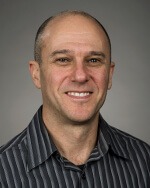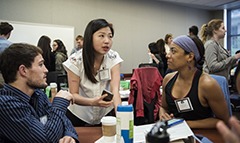Long before Adam J. Bock took first place for his experiential learning exercise, “Innovation Marketplace,” at the 2018 United States Association for Small Business and Entrepreneurship (USASBE) conference, the Wisconsin School of Business lecturer already sensed it might be a winner.
For one thing, he had previously received a lot of positive feedback from his students at the University of Edinburgh in Scotland, where he was a senior lecturer in entrepreneurship when he developed the exercise. “I had students coming up to me later in the semester saying, ‘that was the best activity we did, it was so vivid, so clear,’” Bock recalls, who now teaches in WSB’s Department of Management and Human Resources and Weinert Center for Entrepreneurship.

For another, the lesson seemed to align well with one of entrepreneurship’s fundamentals. He knew that one of the challenges facing new entrepreneurs is their built-in blind spot—they overestimate their innovations’s potential for success. By going through his exercise, they could experience what it was like to “fail” safely and painlessly with nothing at stake.
Bock originally created the exercise in an academic practice course for new faculty at Edinburgh. The class had a unit on engaged learning, and the instructor challenged faculty to select a critical subject in their field and find a more experiential way of teaching it to students in a timeframe of 10 to 30 minutes.
“When you’ve actually seen a really good innovation or technology fail, especially if it’s your own innovation or technology, you never forget that,” says Bock, who is a serial entrepreneur himself, having co-founded five biotechnology companies. “I thought, how on earth in 30 minutes can I have people’s technologies and ideas fail? I came up with this notion that we could have a marketplace of ideas, of innovations, where although the students would be attached to their ideas, it wouldn’t be a life or death thing.”
After the new faculty course was over, Bock’s instructor encouraged him to “actually do something with it,” he recalls. He did—piloting it again in the next semester in an entrepreneurship class on sustainable technologies. He continued to use the exercise in his teaching as a visiting lecturer to WSB in 2013 and then full time as a lecturer in 2017. In 2018, Bock was one of 10 finalists invited to USASBE’S entrepreneurial experiential education contest, the “3-E Learning Competition,” where he took home the top prize.
One of the advantages of “Innovation Marketplace,” Bock says, is that it’s adaptable to any audience. He’s taught it to groups all over the world, from computer science students in Edinburgh to engineering students in Moscow to art students in Austin. He also uses it in his own curricula at the renowned Weinert Center for Entrepreneurship, where his courses in entrepreneurial growth strategies, entrepreneurial management, small business planning, and technology entrepreneurship are among the Center’s portfolio of offerings for future entrepreneurial leaders.
How “Innovation Marketplace” works
The activity itself is “incredibly simple,” Bock says. In a group format, he asks participants to come up with a specific yet broad innovation, such as improving the experience of flying internationally. The idea must be financially feasible (i.e., between $50,000 and $100,000) and short enough to write on a Post-it note.
Next, he asks participants to talk to as many people as possible about their ideas for 15 minutes. If a student likes someone else’s idea better than his own, he gives that person his Post-it note and becomes a follower on that person’s team.

Bock then asks everyone still holding a Post-it note to read it aloud. He marks down the winning innovations and number of followers, ending up with a ranked list of ideas. Bock takes the list and tells participants they have the “best possible list of innovations,” purposely heightening the drama to play devil’s advocate.
At this point, he says, doubts start creeping in among participants; they’re not sure what’s on the list is actually the best representation. Someone might raise a hand and offer that if they’d had more time, the concepts would be better. How much more time is enough, Bock asks the group—10 minutes, a year, 20 years? He says they begin to realize the subjective nature of the process, that “there’s no specific amount of time after which you’re guaranteed you’ve gotten the best possible ideas.”
Understanding innovation drivers
The exercise illustrates that there are any number of different scenarios, factors, and variables that play into whether or not an innovation is successful in the marketplace.
For example, Bock explains, when one participant decides that someone else’s idea is better and hands over his Post-it note, that idea is instantly out of the consideration set. “So now, five seconds into the activity, what may have been the second best idea in the room is gone and never comes back. We refer to that as a path dependence.”
But neither is it always about the best idea. Sometimes the person who is the better communicator gains more followers simply because he can explain his idea better.

And sometimes the process is simply random timing or happenstance. When the instructor starts the exercise, one participant drops her pen on the floor. As she recovers it and turns to talk to the person beside her, that person is already engaged with someone else. “Where you are in the room can determine which innovations win the activity. How terrifying is that?” Bock says. “It has nothing to do with how good the innovation is or how good the communicators are.”
A far-reaching impact
Bock’s innovative teaching methods have raised the bar not only at WSB, but at other higher education institutions as well. Bock has made the “Innovative Marketplace” exercise freely available on the web, and many of the USASBE participants have reached out to Bock for advice as they begin using it at their home universities.
“I’ve benefited from other people’s lessons, plans, and activities. I am just happy to see it used because so many of our students, managers, and executives come into these situations with this perception that as long as they’ve come up with a better product, then by definition, customers will buy it,” he says. “This lesson shows how it’s critical to get early customer feedback and to recognize what the real change processes are for new innovations to be adopted.”
He also hopes the process helps students refine their thinking about why they choose to be entrepreneurs in the first place.
“I teach entrepreneurship and entrepreneurial thinking as a tool for change, as agency. If you have something you really believe in—maybe you want to change the way people buy pizza, or provide a better car rental service, or even cure cancer—do it because it’s something you really want to do,” Bock says. “Be a change agent and accomplish something.”
Tags: